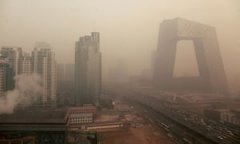Chinese Environmental Issues
 China's sustainability issues are largely linked to the industrial processes that are supporting the country's economic development model. Photograph: Ed Jones/AFP/Getty Images
China's sustainability issues are largely linked to the industrial processes that are supporting the country's economic development model. Photograph: Ed Jones/AFP/Getty Images
The sustainability issues facing China are tied to economic development and the problems are growing in size and frequency
Sustainability in China is a complex problem, encompassing more than solar panels, hybrid cars, and green buildings. There are many reports on the country's deteriorating environment and the problems this causes - from air pollution to "cancer villages" near dirty factories, to the devastation caused by partially manmade droughts and floods. Yet, equally, there are also reports about the progress Beijing is making in green investments and how in some areas it is even leading the west.
How China defines sustainability matters
For generations, the notion of sustainability for most Chinese meant simply having enough to eat. For many, life is much improved. Since China started adopting free enterprise in the early 1980s, an estimated 400 million have been lifted out of absolute poverty and it now has a prosperous middle class. But unrestrained growth has brought problems of its own. These include rampant corruption, growing social unrest because of the widening gap between rich and poor, and a wide array of environmental problems.
Looking at sustainability issues in China today, it is important for outsiders to understand the following:
• China's issues of sustainability are not historically linked to private consumption as they are in the United States or western Europe; they are linked to the industrial processes that are supporting China's economic development model.
• China does not see emissions as a problem that must be dealt with immediately. With millions remaining in poverty, economic growth is still the priority.
• The largest pressure China faces to solve sustainability issues comes from within. External pressures or concerns about the planet as a whole are secondary.
Simply put, the issues that China faces are largely tied to economic development, the problems themselves are growing in size and frequency, and China will do what it takes to fix those problems in a way that considers the needs of its people first.
As we have seen in recent years, China's ability to manage stable growth and create a balance between economy, environment, and society has proven limited; nearly every day there are reports of another problem. This has the effect of creating a wider public awareness. In China, it is more personal, more tangible. Environmental and safety disasters are occurring in individuals' own backyards, and this is moving people to demand more from their leaders.
For some, it is a strong central government that provides hope that China will make changes. Yet at times it is the system itself that hinders the process of identifying and solving problems.
Take the, where a strong central government plan to improve the efficiency of its rail network ultimately created a process whereby a number of safety procedures were overlooked to complete the project quickly.
In addressing its sustainability challenges, China will employ a number of tools to help make the necessary adjustments. It is a process that has already begun, primarily in areas where economic development is the most advanced, and has involved policies, technological solutions, and awareness and engagement campaigns.
Policies
This is where many believe that the biggest changes will occur, as Beijing looks to tighten regulations and enforcement in critical areas of the economy to drive change. The most widely used tools to date have fallen into several categories:
Technology
With the dynamics and complexity of the issues that China faces, the role of technology (or cleantech) will play two prominent roles.
Awareness and engagement campaigns
One of the big questions is what the role of NGOs will be, particularly as agents of awareness. With a history of poor ties to central government, which often views NGOs with suspicion, only a few NGOs have been able to gain enough traction to stabilise their operations in more than one city, and fewer still have been able to do so with the full blessing of the government.
Getting rid of the bad
With so many environmental failures leading to social instability, China's leaders have begun to understand that changes need to be made to the old economy. This was made clear in 2007 when China's second largest fresh water lake experienced a massive algae bloom, which ruined a popular tourist destination and resulted in a water shortage for three million people for nearly two weeks. It was an "AHA" moment for many, particularly those nearest the lake, and it was one of the first tipping points where China's planners began connecting the dots between economy and ecology.
China's problems are complex and growing. As a result of economic hyper-expansion and ignoring the damage that was being done, China's economic, environmental, and social resilience has diminished. While historically the costs of fixing the problems may have been seen as too great, the country is running out of options.









